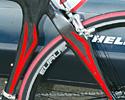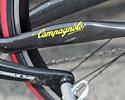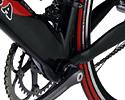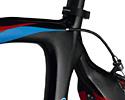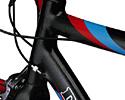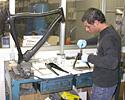
Recently on Cyclingnews.com |
On test: De Rosa Tango, October 20, 2005
An exercise in uniqueness
During the past fifty years the De Rosa family has created some of the best bicycles the cycling world has ridden, from the start with Ugo De Rosa working in a small workshop to the entire family growing it to one of the world's finest cycling companies. In short, the De Rosa name is synonymous with high quality. When the newest addition to the De Rosa line-up landed on the doorstep of Cyclingnews' North American Editor Mark Zalewski, he could not wait to take the Tango for a dance.
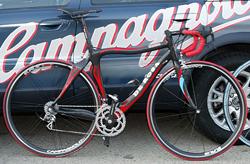
|
When I first laid eyes on the De Rosa Tango, I wondered if the carbon had melted in the hot Midwest sun while traveling on the Campagnolo service car's roof rack to me. With uniquely sloping top and down tubes, combined with exquisitely carved seat tube and rear stays, the Tango is as much of a work of art as it is a racing machine. But then again, should we expect anything less from the De Rosa master and his sons?
The company says one of the benefits of the unconventional design is to make its sloping geometry virtually invisible to the human eye -- something out of a brain teaser I suppose. Whatever the result, most human eyes that this bike fell under gave it more than a second look and jaws routinely had to be picked up off the ground. Even a few U.S. domestic pros gave it a roll around the parking lot and had to be reminded of their team's bike sponsorship (and threatened with the publication of incriminating photos) before reluctantly dismounting the Tango and sulking back to their own rides.
As for the business-end of the frame design, De Rosa says, "The frameset is formed of various monocoque elements: main triangle, oblique and horizontal tubes in the rear end -- which form a very reactive and comfortable structure." This way of forming a carbon frame, with multiple monocoque sets, allows for more flexibility and creativity in the bike design. The shapes of the tubes are quite interesting, particularly the seat and chain stays. The seat stays extend to form a fairing around the rear brake, contributing to the aerodynamic and aesthetic attributes of the frame, while the chain stays enlarge for increased strength.
Cristiano De Rosa, son of Ugo, explained to Cyclingnews earlier this year that the, "Tango has a moncoque front triangle in a revolutionary shape that offers a ride that is both lively and comfortable." Additional carbon is added around the bottom bracket to increase the overall rigidity.
The carbon frameset is thankfully not overly painted to obscure the naked beauty of the material. The test model was the Ribbon color scheme, with a flowing mix of light blue and red accents. This was enhanced by the set-up mechanic Jose Alcala with matching red De Rosa bar tape, and even matching colors of electrical tape to finish the job. The monocoque design is provided exclusively for De Rosa by Dedacciai. And that Dedacciai carbon is not put into the mold until you put your order in, since all De Rosa's are made to order.
However, De Rosa hasn't chased the gram-counters with the Tango, preferring to opt for strength and stiffness over low weight. As a results, frame and fork weigh almost four pounds and the UCI weight police won't be bothering you any time soon. But the trade-off will be more than bearable for the sprinters in the pack.
Components
I am not one for superstition, but many aficionados of Italian design, form and function say that putting anything but Italian bits and parts on an Italian machine is sacrilegious, darling. Lucky for me, the Tango came supplied with the Campagnolo Chorus 10 group and corresponding Campagnolo Eurus G3 wheels clothed in truly Italian Vittoria tires with (of course) matching red treads.
As for the Chorus group, the test ride came with a Chorus CT carbon compact crankset. Compact gearing is the latest rage amongst people who fear slapping a "granny gear" on their super high-end road machines. This compact crankset featured a 34-50 set-up with 172.5mm carbon composite crank arms and a 12-25 Chorus sprocket in the rear.
This compact gearing is certainly nice when hauling the bike up a Alpine mountain climb, but for the fast and flat courses of the American criterium, the lack of firepower in terms of chain teeth might make a difference for some. Nonetheless, I can report that the shifting was typical Campy-smooth and decisive and the carbon crankarms were a sharp visual complement to the carbon frame.
Stem and handlebars were courtesy of Deda and its Newton system, providing rigid and strong steering to many of the Pro Tour teams and now, yours truly. The handlebar was the anatomic design, providing a comfortable place for my hands when diving hard corners (or just trying to look like it.)
Campagnolo makes a strong line of wheels and the Eurus G3 pair is a medium-profile workhorse in the Campy stable. The 30mm aluminum rims make for wheels that are light at just 1560g, yet they are responsive to hard cornering and good jumping out of turns. The aluminum braking surface also stood up to multiple Midwestern summer showers, giving the Chorus brakes a good surface to grab. The HPW oversized hubs feature Campy's quick lubrication ports, but more importantly, rolled exceptionally smoothly. The front wheel is radially spoked with stealthy black double-butted aero spokes while the G3 spoking on the rear wheel is claimed to give increased power transfer and a don't-even-try-it look.
As mentioned earlier, keeping with the Italian heritage, Vittoria tires were wrapped around the Eurus wheels. Conditions that these sharp red treads were tested on varied from smooth, dry pavement along the lakefront of Chicago to very bad, pot-holed, ground that once could have been pavement along the lakefront of Chicago. Then after the first day of riding, the bike was tested under racing conditions from dry, flat criteriums to wet, hilly road races. After miles of beatings, races and training the tires showed nominal wear and no imperfections -- and not one flat tire! Cornering was no problem and it took little time for me to feel comfortable taking the steepest lines through tight turns.
It is not enough that the entire frame is carbon, De Rosa went and threw in a De Rosa seat post made of carbon. Atop the post was a matching red and black Fizik Airone saddle, which I must say fit me rather well. Rounding out the package is a carbon bottle cage by Elite, making the Tango a little jealous by weighing only twenty-five grams!
Let's dance
To say that I enjoyed my ride on the Tango is like saying Lance Armstrong was a little particular about his training. This bike is made for two things -- giving the user a top-end ride and making his/her friends superbly jealous. Even though the latest rage with carbon bikes is to test the patience of the UCI weight watchers, it is nice to know that some are building frames that utilize carbon's damping qualities and yet produce a stiff and responsive ride. Cornering and accelerating were spot-on, with high torsional and lateral rigidity transferring power to the places where it does the most good. This is where the addition of carbon around the bottom bracket really pays off.
As mentioned before, this bike is not for Alpine climbs -- and you can feel the weight on longer, rolling hills. However, once over any ascents, the descending on the Tango is steady and true. Taking this bike up to speeds reaching 60 mph was no problem with little or no wobbles or vibrations. Cornering downhill was equally satisfying and overall maneuvering was tight. Nonetheless, this bike is built for going fast where weight does not matter -- criteriums and flat road stages.
But contrary to that idea comes another quality I enjoyed about the Tango, namely how comfortable it was for longer rides. Much of this is no doubt due to the absorption quality of the 1750 grams of carbon and with less than perfect roads, it handled every bump and pothole thrown its way (as there were many!) Under racing conditions the bike never let me down. Even though I do not normally ride a compact geometry frame, I liked the way it felt under me and pushing hard on the cranks delivered the desired impact.
As for drawbacks, the biggest problem I ran into involved every bike's enemy, especially carbon, water. I rode in two races with the rain gods jealous of my temporary ride. The first was an utter downpour for two hours, the second was some rain from above but more that was already on the road. Both times the Tango retained water like a sponge, with most of it finding its way in through the notch at the top of the seat tube. After twenty minutes of riding, removing the seat post and turning the bike over saw about a half-bottle pour out of the seat tube. However, a little strategically placed silicone and maybe a couple of drain holes would easily solve this problem. Otherwise there will be many bottom bracket overhauls in the future. And while I am not sure how much the rear fairing around the brake contributed to my speed, it did hinder adjustments slightly.
Conclusion
The Tango is a dream ride with flair and style. Maybe a little heavy for some tough climbs, but sprinters will appreciate the stiffness that comes from the added layers of carbon. And no matter what, rolling up to the local coffee spot for the start of a group ride on this machine will turn just about every head -- and that is a feature not found on just any bike.
Pro: Strong and rigid, beautiful design
Con: High water retention, heavier than some
Cyclingnews Rating: ![]()
Full specification: De Rosa TangoFrame: Dedaciai carbon fibre, sloping geometry Cranks: Campagnolo Chorus CT 50/34 |
RRP: Frame and fork - US$2,600.00; Complete bike - US$5,500.00Wheels: Campagnolo Eurus G3 Stem: Deda Newton Pedals: Not supplied More information: www.derosanews.com or www.albabici.com |

